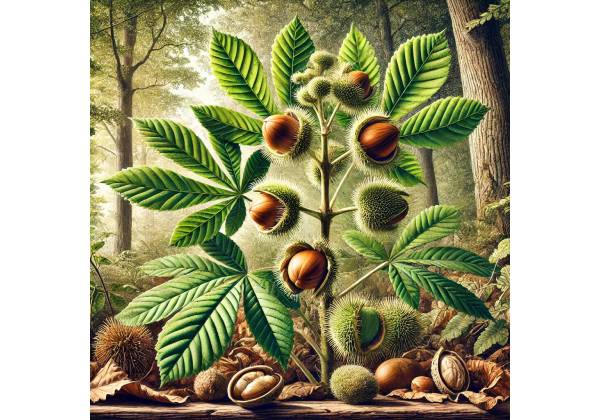
Buckeye nuts are well-known in parts of North America, especially in the regions where buckeye trees naturally thrive. The glossy seeds—sometimes called “horse chestnuts” (though they come from different but related species)—have intrigued people for centuries with their distinctive appearance and reputed properties. If you’ve ever picked up one of these smooth, mahogany-brown nuts in the fall, you might have noticed the striking pale spot that looks like an eye—giving rise to the name “buckeye.” While many folks consider them primarily a charming token of good luck or a seasonal decoration, these nuts and the trees they come from actually have a long and varied history.
In certain folk traditions, carrying a buckeye nut in your pocket was believed to bring fortune and ward off ailments. Beyond just superstition, parts of the buckeye plant have occasionally been studied or used for potential medicinal applications, though caution is necessary due to potentially toxic components. As with many natural items that straddle the line between remedy and hazard, it’s essential to understand the specifics: how to correctly identify the buckeye tree, what the nuts contain, and how they might be processed. Below, we’ll explore every angle of the buckeye nut’s story—from its botanical background to the best ways (if any) to harness its properties safely.
- Often carried as a good-luck charm or stress reliever
- Contains specific compounds that, in controlled forms, may aid blood vessel relaxation
- Historically seen in folk traditions for mild joint or muscle comfort
- Potential antioxidant elements in certain buckeye extracts
- Showcases cautionary usage guidelines due to toxic saponins
Table of Contents
- Buckeye Nut Identification: A Botanical Overview
- Buckeye Nut Historical Backdrop and Folk Lore
- Phytochemistry: Unpacking Buckeye Nut’s Active Components
- Potential Health Benefits Attributed to Buckeye Nut
- Distinctive Buckeye Nut Properties That Stand Out
- Buckeye Nut Uses, Applications, and Safety Considerations
- Relevant Scientific Studies and Notable Findings on Buckeye Nuts
- Buckeye Nut FAQ
Buckeye Nut Identification: A Botanical Overview
The term “Buckeye” typically refers to various trees in the Aesculus genus found in North America. These trees produce nuts (or seeds) encased in a spiky or bumpy husk. When that husk splits open, the glossy brown seed inside emerges, sporting a lighter-colored scar reminiscent of a deer’s eye. The most recognized species in the United States include the Ohio buckeye (Aesculus glabra), the American buckeye (Aesculus pavia), and the California buckeye (Aesculus californica). Although they share certain similarities, each species has distinct traits and regional habitats.
Key Tree Features and Growth Pattern
- Leaves
- Buckeye leaves are palmate—arranged like fingers radiating from the palm of a hand. Depending on the species, each leaf typically has five (sometimes seven) leaflets. They’re often large, with serrated margins.
- Flowers
- In spring, buckeye trees produce upright clusters of tubular flowers, often yellowish-green or red-hued. These blossoms can be quite eye-catching, making the tree ornamental as well.
- Fruit and Husks
- Come late summer or fall, the fertilized flowers form spiny or warty husks, each containing one to three shiny seeds (nuts). The exterior husk can vary in texture among species—some are smoother with small warts, others have obvious spines.
- Seed Appearance
- When removed from the husk, each nut is hard, glossy brown, and typically has a round shape with a flattened area. That distinctive lighter patch is the “eye” or hilum.
Geographic Distribution
- Ohio Buckeye (Aesculus glabra)
Native to the Midwestern and lower Great Plains regions of the United States, famously associated with Ohio, from which it gains its name. - Yellow Buckeye (Aesculus flava)
Found primarily in the Appalachian region, often near streams and rich mountain soils. It can grow taller than some other species. - California Buckeye (Aesculus californica)
Flourishing on the West Coast, known for a different growth cycle that can cause early leaf drop to avoid summer drought. - Red Buckeye (Aesculus pavia)
Common in the southern and eastern US, recognized for showy red blooms that can attract hummingbirds.
Seasonal Patterns
- Spring Leaf-Out and Bloom
- Leaves usually appear in early to mid-spring, followed closely by flowering. The blooms can last a few weeks, supporting pollinators like bees or hummingbirds (especially the red or pink-flowered varieties).
- Summer Fruit Development
- As the weather warms, small, spiked seed pods develop and grow until late summer, at which point they start to dry and prepare to open.
- Fall Maturity
- In autumn, husks may split open to release the shiny nuts. This is also when buckeye leaves often turn yellowish-brown and drop off—some species can lose foliage earlier than typical broadleaf trees.
Identifying Buckeye Nuts
- Size and Shape
Buckeye nuts range from about an inch (2.5 cm) in diameter for smaller species to larger, marble-like seeds. The shape is roundish to slightly oblong. - Color
Typically, a deep brown or mahogany hue, with a portion of lighter, beige coloring that looks painted on. - Texture
Smooth, polished feel, reminiscent of chestnuts but with that distinctive patch or “eye.”
Look-Alikes
- Horse Chestnut (Aesculus hippocastanum)
A closely related species from Europe that produces similar seeds. In many casual references, horse chestnuts and buckeyes can be conflated. Both seeds contain toxic saponins, and caution is advised with either. - Inedible Seeds
Some other broadleaf trees yield somewhat shiny seeds, but few carry the exact shape/color combo of a buckeye. Always confirm identification if you plan any usage (even though direct consumption is generally not recommended).
Recognizing a buckeye nut means looking for that glossy, chocolate-brown sphere with a pale patch, often found on the ground beneath a spreading tree with palmate leaves. Although the nuts can appear enticingly plump, they’re not something to casually snack on—buckeyes contain compounds that can be toxic. The next sections go deeper into historical lore, chemical properties, and any potential ways to use them safely.
Buckeye Nut Historical Backdrop and Folk Lore
The buckeye tree, especially the Ohio buckeye, holds a unique place in North American culture. Over generations, the seeds have moved from woodland floors to the pockets of curious humans—sometimes purely for good luck, sometimes for minor medicinal attempts. Understanding how people in different regions have perceived buckeyes provides a colorful lens into the nut’s cultural role.
Indigenous Awareness and Uses
- Native American Traditions
Various tribes might have recognized the buckeye tree, though specific references in documented ethnobotanical works are limited. Some used parts of the tree for tasks like fish-stunning or simple homemade remedies. The seeds’ toxic properties lent themselves to certain resourceful techniques (for instance, throwing seeds in water to temporarily stun fish). - This usage is akin to saponin-rich plants in other parts of the world—employed to paralyze fish for easier capture.
Early European Settlers
- Frontier Remedies
- 19th-century settlers and traveling “doctor” peddlers sometimes claimed that the buckeye seeds could help with rheumatic pains or varicose veins, often advising people to carry a nut on their person. The idea likely stemmed from the principle of sympathetic magic or mild compression effects from the nut’s shape.
- Some accounts mention ground or pulverized buckeye seeds in poultices, though the line between folk belief and actual efficacy can be hazy.
- Lucky Charms
- Notable references indicate how a buckeye in one’s pocket was considered a lucky piece. This tradition continues in some rural communities and has merged with general “good luck charm” culture in parts of the Midwest.
- The name “buckeye” itself was linked to the seeds resembling the eye of a deer—a known emblem of good fortune in multiple traditions.
Rise of Regional Identity
- Ohio Buckeye
- The state of Ohio adopted the buckeye as a symbol, influencing sports teams (like The Ohio State University adopting “Buckeyes” as their nickname) and general local pride. Souvenir shops often sell polished buckeye seeds or buckeye candies (the latter is actually peanut butter dipped in chocolate, shaped to mimic the nut’s appearance, but safe to eat—unlike real buckeyes).
- Superstitions and Customs
- Across the Appalachian region, an older custom was to pass along a buckeye seed to children, hoping to safeguard them from colds or other ailments.
- One tradition claimed that rotating the nut in your hand or rubbing it could help relieve arthritis or rheumatism pains.
Modern Shifts and Understanding
- Commercial Products
- Some crafters produce decorative items—like jewelry or keychains—using real buckeye seeds. Polishing the seeds reveals a lustrous finish, making them an appealing small accessory.
- Meanwhile, certain herbal remedy websites occasionally mention buckeye extracts or topical balms, though mainstream acceptance is limited due to toxicity concerns.
- Changing Views on Toxicity
- As scientific knowledge expanded, it became clear that buckeye seeds contain saponins and other potentially harmful compounds. This knowledge tempered older anecdotal claims that direct ingestion might be beneficial.
- However, carrying the seed or using it in an external product doesn’t pose the same level of risk as ingesting it, so the tradition of carrying a “lucky buckeye” persists.
Cultural Fusion and Continuation
- Appalachian and Midwestern Heritage
In places like Ohio, Kentucky, or West Virginia, you can still find references to buckeye seeds as good-luck tokens. At local fairs or festivals, you might spot booths selling polished buckeyes or comedic T-shirts referencing the “power” of the seed. - Blending Legend with Caution
Even though the seeds hold symbolic meaning, wise folks and educational displays consistently caution that real buckeye nuts aren’t edible. The boundary between cultural reverence and medical usage is a delicate line.
In short, the buckeye nut’s history weaves folklore, rudimentary remedy attempts, and regional pride into a single narrative. It’s a story of a distinctive seed that has hopped from practical fish-stunning to magical pocket charm to beloved state icon. While modern medical science might not endorse ingesting buckeye seeds for any cure, the cultural significance they carry ensures that these shiny brown tokens remain cherished as conversation pieces and local emblems well beyond the tree’s native woodlands.
Phytochemistry: Unpacking Buckeye Nut’s Active Components
The glossy surface of a buckeye nut might seem unassuming, but beneath that smooth shell lies a mixture of compounds that impart interesting—and sometimes hazardous—properties. As with many seeds containing saponins and glycosides, understanding these chemicals is key to separating myth from potential use or misuse.
Main Categories of Compounds
- Saponins
- A principal group in buckeye nuts is saponins, which can produce a soapy lather when mixed with water. In nature, saponins serve a protective role for the plant, deterring herbivores or pests.
- In humans, saponins can irritate the digestive tract if ingested, leading to symptoms like nausea or diarrhea. High enough doses pose greater toxicity concerns.
- Glycosides and Escin-Like Agents
- The seeds might contain certain glycosides reminiscent of “escin” found in horse chestnut (Aesculus hippocastanum). Escin can have vascular effects, potentially influencing vein tone or edema.
- While horse chestnut extracts are recognized in some conventional medicines (under safe processing), buckeye nuts have not undergone similar mainstream standardization.
- Alkaloids or Tannins (Trace Levels)
- Some references mention smaller amounts of alkaloids or tannins in buckeye seeds. Tannins lend a bitter flavor and can have astringent properties, although they aren’t the focal compounds in buckeyes.
Potential Effects on the Body
- Toxicity Risk
- Ingestion of raw buckeye nuts can lead to gastrointestinal distress, neurological symptoms, and more severe outcomes. This is the primary reason to avoid eating them casually.
- The presence of saponins is likely the main culprit for acute toxicity, as these can break down red blood cells if introduced into the bloodstream in significant amounts.
- Possible Venotonic Influence
- If properly processed (similar to how horse chestnut preparations are made), the compound profile might theoretically yield mild venotonic or anti-edematous effects. However, standardized buckeye-based remedies are not common, and self-processing can be risky.
- Anecdotal Anti-Inflammatory Properties
- Historically, some folks used poultices with ground or boiled buckeye seeds around swollen joints. The impetus was to harness perceived anti-inflammatory or analgesic benefits.
- Any real effect might tie to the saponin or glycosidic components, though no official medical guidelines endorse this.
Comparisons to Horse Chestnut
- Chemical Similarities
Both belong to the Aesculus genus, so they share akin saponins (notably “aescin” or “escin”). However, horse chestnut is more widely researched and processed for medical applications, whereas buckeye remains overshadowed by toxicity worries and lesser-known data. - Different Concentrations
Even within the same genus, the ratio or specific types of saponins can vary, making one species more or less toxic. The relative safety margin for horse chestnut extracts is better established than for buckeye extracts, which remain less thoroughly studied.
Heating, Processing, and Detoxification
- Leaching Techniques
- Some older references mention that Native Americans or early settlers might have leached or boiled seeds to reduce toxicity before any limited usage. Soaking or repeated boiling presumably diluted or removed some saponins.
- However, no widely recognized, surefire method exists for reliably detoxifying buckeyes to safe edible standards.
- Extraction for External Use
- Some people experiment with making a water or alcohol-based extract for topical salves. While this could minimize ingestion risk, measuring the final saponin content is tricky, risking potential irritation.
Modern Analytical Gaps
- Few Peer-Reviewed Studies
The scientific community largely focuses on horse chestnut as the go-to Aesculus species for medicinal exploration. Buckeye species remain less tested. - Variability in Seeds
Even within a single species, climate, soil conditions, and seed maturity can shift the concentration of active compounds—complicating general statements about potency.
Potential for Future Research
- Therapeutic Extraction
If a commercial interest arises, labs might develop processes to isolate beneficial glycosides from buckeye seeds while removing toxic elements. This parallels the horse chestnut model, where specialized extracts are used in some circulatory remedies. - Biopesticidal or Agricultural Roles
Because of their toxicity, saponin-rich plants sometimes see use in natural pest control. Possibly, buckeye seeds could be harnessed this way in controlled contexts—though environmental safety and specificity must be evaluated.
In essence, while buckeye nuts do pack a biochemical punch, that power mostly manifests as cautionary toxicity rather than an open invitation to craft at-home remedies. A curious mix of saponins, glycosides, and lesser-known compounds marks them as interesting from a phytochemical standpoint—but it’s precisely these elements that call for respect and careful handling.
Potential Health Benefits Attributed to Buckeye Nut
Buckeye nuts have a storied place in folklore as a cure-all for everything from rheumatism to hemorrhoids—at least if you ask 19th-century frontier peddlers or read certain old diaries. However, in reality, the line between tradition and proven effectiveness is blurred. Below, we break down some commonly mentioned health claims and evaluate them in light of current knowledge.
1. Musculoskeletal and Joint Support
- Carrying a Buckeye
One of the oldest beliefs is that simply keeping a buckeye in your pocket or rubbing it on a sore area might relieve joint pain, specifically rheumatism or arthritis. This idea rests more in the realm of superstition than medical science. - Some people do claim mild “pressure therapy” or mental comfort from holding the smooth seed, but it’s not a medically validated approach.
- Possible Anti-Inflammatory Action
Saponins in Aesculus seeds (like escin in horse chestnut) have been studied for anti-inflammatory effects. In the case of buckeye, no major clinical trials confirm these benefits. Any reported improvements are largely anecdotal.
2. Circulatory or Venous Health
- Comparison to Horse Chestnut
Because horse chestnut extracts can help with varicose veins or venous insufficiency, some suspect that buckeye seeds share a similar capacity. Indeed, both seeds contain akin saponins, but the research for buckeye specifically is minimal. - Trying raw or home-processed seeds is risky. If you’re seeking vein support, commercially standardized horse chestnut extract is the safer, more studied route.
- Emphasis on External Use
If buckeye is used at all, many older folk methods involved topical poultices, presumably aimed at reducing swelling or inflammation. However, the risk of skin irritation remains, so it’s not widely practiced in modern herbal circles.
3. Pain Relief and Neuralgia
- Historic “Amulet” Approach
Just as people carried buckeyes for arthritis, some believed it might ease neuralgia or migraines if held to the temple or worn around the neck. This is purely anecdotal, lacking scientific foundation. - Limited Topical Preparations
A few Appalachian remedies mention ground buckeye seeds mixed with lard or wax to form a salve for sore muscles. Yet, documented success stories or formal evaluations are scarce.
4. Stress or Anxiety Alleviation
- Fidget Value
Some note that toying with a buckeye nut in one’s hand can bring about a calming sensation. The smoothness and novelty might function akin to a worry stone, offering psychological comfort rather than biochemical sedation. - Lucky Charm Effect
Sometimes the sense of reassurance from carrying a “lucky buckeye” might reduce stress for those who believe in it. This is less about the plant’s chemistry and more about placebo or personal tradition.
5. Digestive or Gastrointestinal Claims
- Pre-Modern Tonics
Certain 19th-century folk recipes combined buckeye seeds with whiskey or other herbs for “stomach calmers,” claiming mild benefits. The saponin content, though, could irritate the digestive tract if not carefully processed. This approach is not recommended today. - No Contemporary Validation
Modern herbal references rarely list buckeye nuts for GI aid. The potential for toxicity overshadows any minor benefit that might exist.
6. Hemorrhoid Relief
- Supposed Venotonic Properties
Because of the partial overlap with horse chestnut’s compounds, some older resources suggest buckeye might help with hemorrhoids by strengthening vein walls. But there’s no recognized, safe buckeye-based product for this. The risk of toxicity via ingestion or unverified rectal application remains high.
7. Performance Enhancer or Energizer?
- Debunking Myths
You might find random claims on the internet about buckeye seeds boosting stamina or offering magical energy. There’s zero evidence for that, aside from psychological or symbolic significance.
8. Brain Health or Cognitive Function?
- No Documented Link
Very rarely, unscrupulous sources might tout a “nut for your brain,” referencing the seed’s shape. This is pure misconception. No credible data indicates buckeye seeds benefiting cognitive performance.
Balancing Folklore with Reality
It’s clear that while the buckeye nut has historically been assigned a whole host of benefits, most revolve around folklore, charm, or minimal external usage. Modern science does not endorse ingesting raw or lightly processed buckeye seeds for any health gain. The toxic saponins overshadow potential positives, absent thorough processing akin to horse chestnut’s specialized extracts. Even so, the cultural significance and anecdotal testimonies keep the mystique alive.
If you’re intrigued by the notion of harnessing similar benefits, consider well-established Aesculus species like horse chestnut extracts, standardized and sold under controlled formulations. The bottom line: buckeye nuts might be fun to carry as a pocket piece or decorative item, but they aren’t a go-to for recognized medicinal therapy in today’s world.
Distinctive Buckeye Nut Properties That Stand Out
Buckeye nuts strike an immediate impression—polished, glassy seeds with that unique lighter “eye” spot. Beyond just their appearance, they possess several attributes that make them a conversation starter or folk curiosity. Below, we explore the intangible qualities that set them apart from your average tree seed.
1. Smooth, Eye-Catching Exterior
- Aesthetic Appeal
The high shine and contrast between dark brown shell and pale mark are aesthetically pleasing, enough to turn them into small crafts or jewelry. For some, that alone justifies collecting them each autumn. - Tactile Satisfaction
Holding a buckeye nut can be oddly soothing. Many describe them as perfect “worry stones,” which you can roll around in your hand. The seeds’ shape and texture invite tactile engagement.
2. Connection to Symbolism and Luck
- Folklore and Good Fortune
Possibly their strongest intangible property is this sense of luck or superstition. In places like Ohio, the seed is practically a state emblem. People slip them in their pockets or purses, hoping for positivity. - Heritage Link
The synergy of being an instantly recognizable local token fosters a cultural identity. For diaspora from those regions, carrying a buckeye might evoke nostalgia or a piece of home.
3. Seasonal Highlight
- Autumn Collection
Gathering buckeye nuts is a yearly tradition for some families, marking the onset of cooler weather. The hunts can be reminiscent of chestnut picking, though with the difference that these nuts aren’t for roasting. - Transition in Landscape
The tree’s leaves often turn golden before dropping, so discovering newly fallen buckeyes is part of an autumn tapestry in wooded neighborhoods or campus greens.
4. Potential Toxic Strength
- Defensive Mechanism
From an evolutionary viewpoint, the seeds’ saponins deter animals that might otherwise eat them. This underlines how nature’s design can yield a gorgeous seed that, ironically, warns off predators. - Handling Safety
Though simply touching or holding buckeyes is safe for most people, the knowledge that they carry toxins sets a boundary. This dynamic fosters a unique blend of attraction and caution.
5. Ecological Role
- Wildlife Interactions
While many animals avoid raw buckeyes, some squirrels or rodents might nibble them occasionally—but typically reject them once they detect bitterness. Decomposing seeds or husks contribute organic matter to the soil. - Seed Dispersal
Buckeye trees rely partly on gravity (and occasionally curious animals) for dispersal. The seeds’ tough shell can survive the elements until they possibly sprout under favorable conditions.
6. Crafting and Creative Potential
- Decorative Crafts
Polished buckeyes can become beads, decorative bowl fillers, or holiday ornaments. The possibilities are limited only by imagination—though large-scale usage is less common outside the Midwest or Appalachian craft fairs. - Whimsical Branding
Some local businesses incorporate “Buckeye” into their name or logo, capitalizing on the immediate recognition that this seed fosters. For example, “Buckeye Crafts” or “Buckeye Candle Co.” taps into a sense of place and tradition.
7. Accessibility and Abundance
- Freely Available
In areas where buckeye trees thrive, seeds are abundant each fall, easily gathered by anyone interested. This “pick-up-and-go” aspect differs from more elusive or restricted herbal items. - Limited Commercial Market
Aside from small novelty items, there isn’t a massive commercial pipeline for raw buckeye seeds, partly due to toxicity and limited demand. This keeps them more in the realm of local or personal usage.
Ultimately, the buckeye nut’s distinct properties lie not just in chemical potential but in how it intersects with human culture—feeling both natural and mystical. Its visual charm, storied luck, and toxin-laden composition create a fascinating package that transcends typical “nut or seed” categories. From the perspective of nature-lovers, crafters, or the simply curious, a buckeye nut stands as a small, shiny testament to the complexity and beauty found right under our feet each autumn.
Buckeye Nut Uses, Applications, and Safety Considerations
While the previous sections highlight the buckeye nut’s interesting appearance and cultural significance, the question of practical usage looms large. Are there safe ways to incorporate buckeyes into crafts, traditions, or even limited health practices? Below, we dissect the “how-tos” and the do’s and don’ts you need to keep in mind.
1. Crafting and Décor
- Pocket Charms and Worry Stones
- The simplest approach involves just carrying or displaying a raw buckeye nut. Many enjoy the tactile experience or the idea of lucky energy. This usage is entirely safe as long as you’re not biting into it or letting children handle it unsupervised.
- Arts and Crafts
- Polishing the seed to a high shine can create small decorative elements—like beads or pendants. Drilling a hole calls for caution: it’s best to wear a mask or do it outdoors, avoiding inhaling any dust.
- Seasonal decorations: People sometimes gather a collection of buckeyes in a clear vase or incorporate them into wreaths for an autumn display.
2. Historical or Folk Medicinal Approaches
- External Pouches or Liniments
- Some old folk practices mention placing a buckeye nut in a small muslin bag, worn or carried near arthritic joints. Even if any effect is purely placebo, it’s harmless physically (aside from the nut’s dryness and risk of mold if it gets damp).
- A select few references mention liniments using ground seeds, but the risk of skin irritation from saponins remains. If trying anything of this nature, do a patch test first and consult any available professional advice.
- Ingestion Warnings
- The general consensus among modern herbalists: do not eat raw or even lightly cooked buckeye nuts. The risk of severe poisoning from the saponins is significant.
- Traditional methods might have included elaborate soaking or leaching, but verifying safe toxin removal is very challenging.
3. Potential Ornamental Planting
- Aesthetic Value
Buckeye trees themselves can be appealing in landscapes—some produce showy flowers and have decent shade canopies. If you love the seeds but want a sustainable source, consider planting a buckeye tree if your region suits its climate. - Handling Seed Germination
If collecting seeds for germination, remember that the seeds are short-lived once they dry out. Planting them soon after harvest in moist soil can yield success. Keep in mind the tree’s toxic seeds if you have children or pets who might be curious.
4. Modern Herbal Products?
- Rare or Niche
- True “buckeye seed extract” products for internal consumption are not commonly on shelves. Horse chestnut has overshadowed it due to better-defined standardization.
- Always read labels carefully if you encounter an “Aesculus” product, to confirm which species is used and how it’s processed.
- Possible Homemade Preparations
- Some enthusiasts attempt to create a “buckeye tincture” or “buckeye salve.” Without specialized knowledge, you risk ingesting or topically applying harmful levels of saponins. Approaching such experimentation with caution is essential.
5. Toxicity and First Aid
- Symptoms of Ingestion
- If someone swallows raw buckeye seeds or large quantities of derived substance, they might experience vomiting, diarrhea, confusion, muscle weakness, or difficulty breathing.
- Immediate medical attention is critical. Activated charcoal or hospital-based supportive care can help mitigate serious complications.
- Pet Safety
- Dogs, in particular, might be tempted to chew or eat interesting seeds. Buckeyes pose a poisoning hazard, so keep them out of reach. If you suspect your pet has eaten one, contact a vet without delay.
- Safe Disposal
- If you gather lots of buckeyes for décor or crafts and end up discarding them, do so in a manner that doesn’t expose wildlife, especially in areas with curious squirrels or livestock.
6. Who Should Avoid Handling or Using Buckeyes?
- Individuals with Known Allergies
While not a common allergen, any sensitivity to saponins or related compounds suggests caution. Using gloves or minimal contact might be wise if you’re uncertain. - Families with Small Children
Considering the bright, appealing look of the seeds, toddlers might be drawn to pick them up or put them in their mouths. It’s best not to leave buckeyes scattered around in child-accessible spaces.
7. Cultural vs. Clinical
- Respecting Tradition
- The “carry a buckeye for luck” tradition is typically harmless if you’re mindful about not misusing it. For many, it’s a cherished custom or conversation starter.
- Leaning on it as a serious remedy for health conditions, however, remains beyond credible medical practice.
- Potential Placebo or Psychological Comfort
- Even if the direct biochemical effect is minimal, feeling more secure or confident with a “lucky charm” can reduce stress. This intangible effect can be meaningful for some, though it shouldn’t replace legitimate treatments.
8. General Best Practices
- Educate Yourself
If you’re interested in the cultural or craft aspects, a quick read of reputable horticulture or local extension service resources can clarify any region-specific guidelines. - Do Not Taste-Test
The simplest safety tip: never nibble on raw buckeye seeds, husks, or leaves. Even small amounts can upset your GI system or produce more severe toxicity. - Moderate Interaction
Using a few seeds for decoration or carrying them for sentimental reasons is fine, but massive stockpiling or attempts at large-scale remedy-making is ill-advised.
In summary, while buckeye nuts do attract attention, caution reigns supreme regarding any potential “internal” or “medicinal” usage. By sticking to external crafts, symbolic pocket tokens, or purely ornamental roles, you can appreciate their natural beauty and cultural heritage without falling into the toxicity trap. If you do harbor curiosity about deeper medicinal angles, consulting professionals and established references on safe handling is critical—especially since alternative, thoroughly researched herbal routes likely exist for many of the same ailments buckeyes are reputed to address.
Relevant Scientific Studies and Notable Findings on Buckeye Nuts
Buckeye nuts and the broader Aesculus genus have been subject to intermittent scientific attention, primarily overshadowed by the extensively researched horse chestnut (Aesculus hippocastanum). While horse chestnut’s standardized extracts are used in mainstream medicine, buckeye’s role remains more anecdotal. Below are key highlights from available literature and investigations.
1. Historical Pharmacopoeia Mentions
- 19th Century Materia Medica
Some archaic American pharmacopeias included short references to buckeye seeds, paralleling them with horse chestnut. They noted that “bitter seeds” might help with varicose veins or rheumatism, but rarely provided dosing specifics. The recognized risk of poisoning was already cautioning practitioners.
2. Chemical Analysis and Toxicology
- Saponin Profiling
Early to mid-20th-century lab tests—like one published in the American Journal of Pharmacy (1926)—confirmed that buckeye seeds contain saponins, similarly to horse chestnut. The tests delineated various glycosides, but in lesser quantity or somewhat different structures than horse chestnut. - Toxicity in Livestock
Agricultural bulletins occasionally note livestock poisonings after ingesting buckeye seeds or sprouts. A 1970s study from a state university’s veterinary department documented neurological symptoms in cattle, linking it to high saponin ingestion from fallen seeds in pastures.
3. Comparisons to Horse Chestnut
- Escin-Like Components
Because horse chestnut’s main active complex is escin (or aescin), a few academic papers have compared buckeye seeds to see if they yield parallel substances. Some found minor parallels, though the potency or ratio wasn’t as favorable. No industry impetus has spurred creation of standardized buckeye extracts akin to “horse chestnut extract.” - Lack of Official Endorsement
No recognized pharmacopeia currently endorses buckeye seeds as a recommended remedy. Horse chestnut remains the species with official acknowledgment in treatments for chronic venous insufficiency or hemorrhoids.
4. Any Observational or Experimental Trials?
- Scant Human Studies
Searching medical databases reveals scant direct human trials involving buckeye seeds. Some older informal observations or case studies do exist, often with inconclusive or contradictory outcomes. - Animal Model Explorations
Limited rodent experiments in the 1980s tested the analgesic or anti-inflammatory potential of buckeye extracts, producing ambiguous results. The repeated conclusion was overshadowed by high toxicity thresholds.
5. Socio-Cultural Research
- Folklore and Identity
Anthropological or regional studies occasionally mention the role of buckeyes as luck tokens or the tradition in Appalachian or Midwestern communities. While such works highlight the cultural resonance, they don’t affirm any medical claims. - University Extension Publications
Some state extension agencies discuss buckeye toxicity for owners of farmland or livestock, summarizing known hazards and referencing older toxicology bulletins. They rarely mention beneficial effects beyond the intangible or decorative.
6. Potential Environmental or Agricultural Studies
- Allelopathic Studies
An area of possible interest is whether buckeye trees produce compounds that inhibit neighboring plant growth. Some observational notes propose that seedlings rarely sprout close to mature buckeye trees, hinting at chemical interplay. Yet, robust research remains minimal. - Sustainability of Certain Species
With shifting climate patterns, horticulturists have looked at how trees like the Ohio buckeye will adapt. While not focusing on the nuts’ medicinal angle, these studies reflect on viability, seed propagation, and genetic diversity.
Buckeye Nut FAQ
Can you eat a buckeye nut safely if you cook it?
Generally, no. Buckeye nuts contain toxins (notably saponins) that aren’t reliably neutralized by ordinary cooking. Eating them can cause serious digestive upset or worse. While some older references mention elaborate leaching processes, mainstream advice is to avoid consuming buckeyes altogether.
What’s the best way to store buckeye nuts?
If you plan to keep them for crafts or decorative purposes, store the nuts in a cool, dry spot. You might lay them out in a single layer or place them in a breathable container. Ensure they stay dry to prevent mold. Properly cured nuts can last for several seasons without rotting.
Are buckeye seeds the same as horse chestnuts?
They’re closely related but come from different species. The European horse chestnut (Aesculus hippocastanum) is better studied for medicinal extracts. Buckeyes are North American species (Aesculus glabra, Aesculus pavia, etc.). Both seeds carry toxic saponins and should not be eaten raw.
Is it true that carrying a buckeye in your pocket brings good luck?
Many folks in the Midwest and Appalachia hold to that tradition, calling buckeyes “good luck charms.” There’s no scientific backing for it, but it’s a long-standing custom that can provide comfort or nostalgic value for those who enjoy the superstition.
Disclaimer
This article is for educational purposes only and shouldn’t replace professional medical advice. Always consult a qualified healthcare provider before using any plant or seed for health reasons, especially one like buckeye that contains known toxins.
If you found this piece interesting, feel free to share it on Facebook, X (formerly Twitter), or your favorite social platform. Spreading the word helps others learn about buckeye nuts—both their charming lore and the necessary precautions for safe handling!










